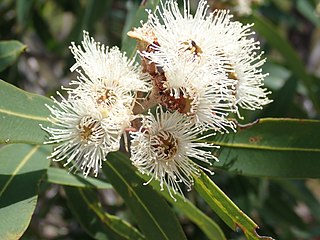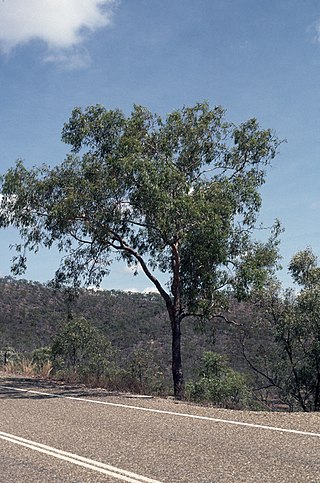
Angophora costata, commonly known as Sydney red gum, rusty gum or smooth-barked apple, is a species of tree that is endemic to eastern Australia. Reaching 30 m (100 ft) in height, the species has distinctive smooth bark that is pinkish or orange-brown when new and fades to grey with age. Its lance-shaped leaves are arranged in opposite pairs along the stems, with white or creamy white flowers appearing from October to December. The flower buds are usually arranged in groups of three, followed by ribbed, oval or bell-shaped fruit.

Angophora bakeri, commonly known as the narrow-leaved apple, is a species of tree that is endemic to New South Wales. It has rough, fibrous bark on the trunk and branches, lance-shaped adult leaves, flower buds in groups of three or seven, white or creamy white flowers and oval to cylindrical fruit.

Eucalyptus expressa, commonly known as the Wollemi stringybark, is a recently discovered Australian tree species. It has rough, fibrous stringybark on the trunk and larger branches, lance-shaped to curved adult leaves, flower buds in groups of between seven and twenty four and hemispherical to shortened spherical fruit with the valves extending well beyond the rim of the fruit.

Angophora bakeri subsp. crassifolia is a small, shrubby tree or mallee that is endemic to a small area of New South Wales. It has rough bark on the trunk and branches, thick, rigid lance-shaped leaves, flower buds in groups of three or seven, white or creamy white flowers and cup-shaped to barrel-shaped fruit. It is similar to subspecies bakeri, differing in its smaller habit, thick leaves and slightly larger fruit.

Angophora subvelutina, commonly known as the broad-leaved apple, is a species of tree that is endemic to eastern Australia. It has rough bark on the trunk and branches, lance-shaped to egg-shaped or elliptical adult leaves, flower buds in groups of three or seven, white or creamy white flowers and ribbed, cup-shaped fruit.

Angophora leiocarpa, commonly known as rusty gum, is a species of small to medium-sized tree that is endemic to eastern Australia. It has smooth bark on the trunk and branches, lance-shaped adult leaves, flower buds usually in groups of three, white or creamy white flowers and smooth barrel-shaped to cup-shaped fruit.
Angophora inopina, commonly known as the Charmhaven apple, is a species of small, often multi-stemmed tree that is endemic to the Central Coast of New South Wales. It has rough bark on the trunk and branches, lance-shaped adult leaves, flower buds in groups of three or seven, white or creamy white flowers and ribbed, cup-shaped fruit.

Angophora woodsiana, commonly known as smudgee, is a species of small to medium-sized tree that is endemic to eastern Australia. It has rough bark on the trunk and branches, lance-shaped or curved adult leaves, flower buds in groups of three or seven, white or creamy white flowers and ribbed, cup-shaped fruit.
Eucalyptus croajingolensis, commonly known as the East Gippsland peppermint or Gippsland peppermint, is a species of tree that is endemic to southeastern Australia. It has rough, short-fibrous bark on the trunk and larger branches, sometimes smooth bark on the thinner branches, lance-shaped to curved adult leaves, flower buds in groups of nine or more, white flowers and hemispherical to cup-shaped fruit.
Eucalyptus volcanica is a species of tree that is endemic to northern New South Wales. It has rough, fibrous to flaky bark on the trunk, smooth bark above, lance-shaped or curved adult leaves, flower buds in groups of seven, white or creamy white flowers and cup-shaped or barrel-shaped fruit.
Eucalyptus ignorabilis is a species of small to medium-sized tree that is endemic to southeastern Australia. It has rough, fibrous bark on the trunk and branches, lance-shaped to curved adult leaves, flower buds in groups of seven, white flowers and cup-shaped to hemispherical fruit. It is found in far southeastern New South Wales and eastern Victoria.

Eucalyptus psammitica, commonly known as bastard white mahogany, is a species of small to medium-sized tree that is endemic to eastern Australia. It has rough, stringy or fibrous, prickly bark on the trunk and branches, lance-shaped to curved adult leaves, flower buds in groups of between seven and eleven, white flowers and cup-shaped to hemispherical fruit.
Eucalyptus retinens, commonly known as Hillgrove box, is a species of tree that is endemic to the Northern Tablelands of New South Wales. It has rough, fibrous or flaky bark on the trunk and larger branches, smooth bark on the thinner branches, lance-shaped adult leaves, flower buds in groups of seven, white flowers and cup-shaped, cylindrical or hemispherical fruit.

Corymbia hylandii, commonly known as Hyland's bloodwood, is a species of small tree that is endemic to part of the Cape York Peninsula. It has rough, tessellated bark on the trunk and branches, lance-shaped adult leaves, flower buds in groups of seven, creamy white flowers and urn-shaped fruit.
Eucalyptus gigantangion, commonly known as Kakadu woollybutt, is a species of tree that is endemic to the Northern Territory. It has soft, fibrous bark most of the trunk, smooth white bark above, narrow lance-shaped adult leaves, flower buds in groups of seven, orange-coloured flowers and ribbed, urn-shaped fruit.

Eucalyptus helidonica is a species of tree that is endemic to an area near Helidon in Queensland. It has rough, finely fibrous bark, lance-shaped or curved adult leaves that are paler on the lower surface, flower buds in groups of eleven or more, white flowers and shortened spherical or barrel-shaped fruit.
Angophora costata subsp. euryphylla is a species of medium-sized to large tree that is endemic to a restricted area of New South Wales. It has smooth bark, lance-shaped adult leaves, flower buds in groups of three, white or creamy white flowers and cylindrical to barrel-shaped fruit. It is similar to subspecies costata but has broader leaves and larger fruit.

Angophora melanoxylon, commonly known as Coolabah apple, is a species of small to medium-sized tree that is endemic to eastern Australia. It has rough, fibrous bark on the trunk and branches, linear to narrow lance-shaped adult leaves, flower buds in groups of three or seven, white or creamy white flowers and cup-shaped, cylindrical or barrel-shaped fruit.

Angophora bakeri subsp. bakeri, commonly known as narrow-leaved apple, is a small to medium-sized tree that is endemic to New South Wales. It has rough bark on the trunk and branches, flower buds in groups of three or seven, white or creamy white flowers and cup-shaped to barrel-shaped fruit.
Angophora costata subsp. costata is a species of medium-sized to large tree that is endemic to eastern Australia. It has smooth bark, lance-shaped adult leaves, flower buds in groups of three, white or creamy white flowers and cylindrical to barrel-shaped fruit. It is similar to subspecies costata but has narrower leaves and smaller fruit.














